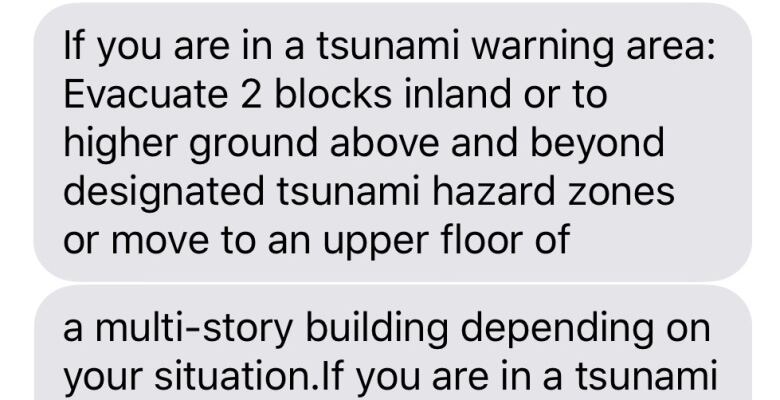B.C. minister promises review of alert system after patchwork of tsunami warnings
From sirens to phone calls, texts or a door-knock, each community has its own emergency plan

Depending on where you live in B.C. you could have heard about Tuesday's tsunami threat several different ways sirens, automated calls, texts, even a knock on the door.
But why wasn't there one single message from one single source?
"There's a whole system of ways of being able to contact people," said B.C. Minister of Public Safety Mike Farnworth. He says the province will review how information was released and how it was received.
"There are different systems in place that meet the needs of ... communities."
Province tells communities,who then tell residents
Early Tuesday morningEmergency Management B.C.issueda warning to communities about the tsunami threat, which then prompts emergency programs to be put into place.
For those places most at risk, such asTofino and Ucluelet, that means sounding beach sirens, sending out an automated phone message to all residents and having officials like firefighters go door-to-door or direct traffic to emergency centres.
"Then social media networks begin firing and people begin calling, and people [start] talking to their neighbours," said TofinoMayor Josie Osborne.
Farnworth says each community'semergency plan, which is worked out in collaboration with the province, reflects unique needs.
"And so from what we've seen, by and large, they work very well," he said. "I'm happy that the system worked."
Peter Este lives three houses from the waterfront in Esquimalt, B.C. Firefightersknocked on his door Tuesday morning.

"I didn't know what it was," he said of the knock. By the time he got downstairs firefightershad moved onto the next house, but in passing told him about the danger.
Este and his wife packed water, mobile phones, some clothes and an iPad, which he said his wife would use to check for updatesat a local emergency centre.
For others in coastal communities like Prince Rupert, upon hearing the warning residents created phone liststo advise others while the city relied heavily on Facebook to get the news out.
That meant multiple people missed the warning entirely.
Others, bizarrely, got information from people abroad who were alerted to the warnings before local residents.
Add in "what's app messages" from Brazil to your collection of notification practices! We are hosting a student from Brazil and I actually first heard about all the activity from his mom IN BRAZIL who sent me a very concerned text!
—@WSwanVictoriaChris Duffy, executive director for operations with Emergency Management B.C., says he's happy with how the alerting went, but acknowledges it's not prefect.
"Certainly I wouldn't say that we're going to reach every person, every time. It would be nice to think that, but I don't think we're at that point yet."
Some residents in Victoria received informationin the form of texts or automated phone callsthat directed them to aU.S. government website about the tsunami threat.
That's because Canada and the U.S. havea bilateral agreement to share this type of information according toMike Angove, the tsunami program manager with theU.S. National Oceanic Atmospheric Association.

He says the agency allowspeople to subscribe to SMS alertsfrom the NOAA and he says the system worked on this threat.
"Overall we're satisfied that the right procedures were followed and the right alerts were issued and the right dissemination routes were available and used," he said.
In May 2017, Victoria put in place an emergency alert system called Vic-Alert.
Subscribers sign up online and can choose to receive notifications by text, email or voice call. The city also recommends selecting the voice call option to receive a wakeup call in the event of any emergency in the middle of the night.
Several other alert systems in B.C. also provide updates on province-wide and national emergencies such as Emergency Info B.C., Alert Ready in B.C. and Environment Canada.
The LTE messaging system used in Hawaii to alert anyone connected to a local cellphone tower about amissile threatwon't be available in Canada until April.
In the event of a #tsunami alert, some communities may activate their warning systems & others may con't to monitor the situation. AlertReady is the provincial system used to notify local authorities & will include text alerts in April 2018. https://t.co/zUtQyvYb6I 1/2...
—@EmergencyInfoBCThat's when the CRTC will require all cell providers to provide AlertReady the ability to send out LTE messaging alerts on their networks.
But even with that enhancement, it won't help people who have their phones off or are in remote areas with no service.
The obvious problem with text messages for the average citizen along the BC coast is that you have to have your cellphone on all night.
—@SalishSeaFutureIn the meantime, Duffy and Farnworth saythe province will use thisclose call to review how the emergency was handled and information was released.
"Technology is advancing at a very significant rate in so many areas that there are obviously going to be ways to make improvements and we want to make sure that those happen," he said.
- For more on preparedness in B.C. listen to the CBC Podcast Fault Lines.
With files from Megan Thomasand Matt Meuse.












_(720p).jpg)


 OFFICIAL HD MUSIC VIDEO.jpg)
.jpg)



























































































